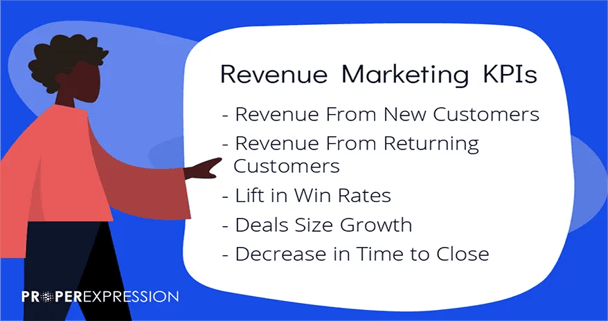Table of Contents
The CEO can be the "make it or break it" of any good company strategy, and how they lead can impact how successful the company is as a whole. Like American novelist Ken Kesey once said, "You don't lead by pointing and telling people someplace to go. You lead by going to that place and making a case."
To ensure that Marketing generates revenue, every CEO should lead on revenue marketing. They should establish a revenue-focused strategy company-wide, setting expectations for marketing’s role in revenue generation. The CEO is instrumental in setting the marketing team up for success as they transition from traditional marketing to Revenue Marketing.
Let's take a look at the three things every CEO can do today to get a better ROI on their Marketing investment.
Develop Measurable Company Goals
 The most important first step to achieving anything in business is having proper goals set to guide your strategies and executions.
The most important first step to achieving anything in business is having proper goals set to guide your strategies and executions.
Company goals, in particular, are the foundation of every other objective throughout the business — marketing, sales, customer service, etc. In fact, setting goals is directly associated with company success.
This might seem obvious enough, but more than 80% of SMBs don't bother to track their business goals (let alone align them across departments).
No matter what goal development process (i.e., GOST, OKRs, etc.) you prefer to use, research shows that having an organized plan of action based on goals can make all the difference. When shared goals are established and known, your company is better positioned to perform.
GOST Framework vs. OKR
GOST stands for Goals, Objectives, Strategies, and Tactics. This framework allows companies to take the next step and develop department plans (company plans, marketing plans, etc.) based on the overall company goals.  Many teams start doing work without a clear understanding of the expected impact of their efforts on what the company is trying to accomplish. This leads to last-minute decision-making and wasted time and money. By using the GOST framework to set and align Goals, Objectives, Strategies and Tactics for the entire company, CEOs can ensure that every department only spends time on activities expected to help move the company towards its goals most significantly. Putting together a GOST framework is also a fantastic exercise to ensure that goals are attainable and that every department comes together to remove any hurdles along the way.
Many teams start doing work without a clear understanding of the expected impact of their efforts on what the company is trying to accomplish. This leads to last-minute decision-making and wasted time and money. By using the GOST framework to set and align Goals, Objectives, Strategies and Tactics for the entire company, CEOs can ensure that every department only spends time on activities expected to help move the company towards its goals most significantly. Putting together a GOST framework is also a fantastic exercise to ensure that goals are attainable and that every department comes together to remove any hurdles along the way.
OKR stands for Objectives and Key Results. OKR is another framework that guides companies in setting and tracking measurable goals. This process clearly breaks down the key company objectives and the KPIs used to analyze each objective's outcomes.
The main difference between the GOST framework and the OKR framework is the level of detail and planning for each main goal. While the GOST framework presents a clear path to achieving the goals, the OKR method only plans for the objectives and critical success metrics (Key Results).
65%
Increase in MRR

65%
Increase in MRR

"ProperExpression revolutionized our business!"
Chelsea Parsons
Sales and Marketing Officer
Why Marketing Often Fails to Generate Revenue
There are a few common reasons businesses fail to meet their revenue marketing goals:
- The goals set are unrealistic.
- Goals aren't backed by research (i.e. goals are not based on historical data, industry data, etc.).
- Goals aren't clearly and consistently communicated throughout all departments.
- Sales and Marketing goals set the teams against each other leading them to play a credit and blame game instead of a team game
- The marketing team is constantly expected to perform activities not aligned with their goals (ie work on sales enablement when they have only lead gen goals, etc.)
- The marketing leader is not empowered to make decisions about the marketing strategy and tactics to be used, how to use their budget, etc.
- There's a gap between employee skills and objectives (make sure you have the right people in place to meet those goals).
- Some of Marketing's contribution to revenue is not attributed properly (ie. some touchpoints happen before someone becomes a lead. This is also known as the "dark funnel")
Aligning Marketing Goals to Business Goals
One of the most important steps to successful revenue marketing is aligning your marketing objectives with the company's goals. It's up to the CEO to know what they need marketing to accomplish in order to support the overall goals. This is where working with your CMO is crucial.
You should work directly with your CMO to identify marketing goals that will allow the company to meet its topline goals. These marketing goals create the foundation of your overall marketing strategy and should inform each decision your marketing team makes.
Every goal set should be measurable and time-bound, as this sets your team up to be able to effectively track and report on progress for each campaign. An understanding of the timeline and definition of success keeps teams motivated to optimize and enhance performance throughout the duration of a campaign in order to achieve the desired outcomes.
Ready to set goals that convert into revenue? Get our Goal Setting Template here!
What Are Examples of Good Marketing Goals?
Keeping your business goals in mind, your marketing goals should be specific, measurable, attainable, relevant, and timely. This will keep them on track to be successful, guide the entire marketing team, and keep everyone organized and on the same page.
Examples of good marketing goals include:
- Revenue Goal: For example, "Increase ARR by 15% over the next year".
- Funding Goal: For example, "Raise $1 million within 6 months".
- Long-term Growth Goal: For example, "Enter new market by sourcing 10 new clients in said market by the end of the fiscal year".
An example of a good objective for goal #1 can be: Increase organic website leads by 25%.
Then a strategy could be: Leverage technical and nontechnical SEO to grow organic website traffic by 25%.
Finally, a tactic could include: Write 10 new blog posts with "XYZ keywords" this quarter to grow organic website traffic.
Each Marketing Goal should be tied to 3 to 5 objectives, each objective should be tied to 3 to 5 strategies, and each strategy should be tied to 1 to 2 tactics.
Review Your Marketing Strategy

To successfully align business and marketing strategies, CEOs need to equip their CMOs and the entire C-suite with the necessary tools. A culture of transparency and collaboration set by the CEO allows the CMO to have a comprehensive understanding of how marketing contributes to achieving company objectives.
With the whole C-suite aligned on the company-wide strategy, the CEO must then support the CMO with the team members, tech stack and other tools needed to set a marketing strategy synched with the business strategy.
What's a Company Marketing Strategy?
A company marketing strategy refers to a business's overall plan of action for reaching and resonating with consumers in ways that elicit purchases, repeat purchases, and loyalty. You can think of it as your game plan for increasing sales and revenue.
To craft an effective marketing strategy efficiently, it is wise to leverage all the levers of revenue marketing beyond “promotion”. Back in 1960, E Jerome McCarthy defined 4 pillars of any efficient marketing strategy, known as the 4 P's of Marketing.
4 Ps of Marketing

- Product: what you're selling to your target audience and how it resolves their problem.
- Price: the cost of your product/service and how consumers perceive it.
- Place: where customers can find your product/services and information about it (i.e., channels and distribution, but also how customers buy: online, via sales calls only, etc.).
- Promotion: the way in which your audience hears about you and how effective it is at reaching them. For instance, your advertisements and PR.
Much like your marketing mix, the four Ps of marketing allow you to better define the tools you need to pursue your marketing goals in your target market. Enabling your team to play with (and test) all levers enables them to have a significant impact on the bottom line.
What Are Examples of Good Marketing Strategies?
A good marketing strategy aligns with your business goals and your revenue strategy. Here are two examples of good marketing strategies to inspire your own.
If you have a business goal of increasing brand awareness and a revenue strategy to increase web sales, you'll need a marketing strategy that appeals to both. In this case, social media may be beneficial because a regular and consistent presence will accumulate more followers and create meaningful relationships with current ones. Using this connection to potential and current customers, you can craft content that directs followers to your product/service website, bringing more awareness to your brand and encouraging sales.
Likewise, a company with a business goal to improve employee satisfaction and decrease the costs of high employee turnover rates would do well to have a marketing strategy in place that highlights the company's core values and culture. This will ensure that you're only attracting top talent that matches your ideal candidates' skills and personality, improving employee satisfaction in the workplace and reducing the direct impact of high turnover on your revenue and profitability.
Set the Right Marketing KPIs
A common mistake marketers make when reporting to their Board is is reporting on unnecessary KPIs (key performance indicators) that don’t help you or your board understand the impact of Marketing on the success of your business.
This includes metrics like bounce rate, time on site, click-through rates, organic rankings, etc. While these metrics are important to your marketing team as it gives them some indication of how people are interacting with their campaigns, they shouldn’t take up the time or attention of the C-Suite. Spending time discussing these metrics with the Board and executive team means spending less time on the things that matter.
When it comes down to it, top-of-the-funnel metrics don't tell you enough about the impact your marketing program has on the company's bottom line and takes up time you could be spending talking about the metrics that do drive revenue. Instead, you need to make sure you track metrics that will tell you if your company marketing strategy is aligned to your company goals.

Ideal KPIs to track in this case would be:
- Revenue From New Customers — i.e., number of active customers, average value per new customer, the average number of transactions per new customer, and average value per new customer transaction.
- Revenue From Returning Customers — i.e., number of returning active customers, average value per returning customer, the average number of transactions per returning customer, and average value per returning customer transaction.
- Lift in Win Rates — i.e., an increase in the percentage of opportunities that became customers. Perform a cohort analysis to understand the influence each marketing campaign has on win rates for existing deals.
- Deals Size Growth — i.e., an increase in the total revenue of all deals divided by the number of deals within a certain time period.
- Decrease in Time to Close — i.e., acceleration between when prospects become open deals and when they convert to customers.
These are just a couple of examples. The right KPIs for your company marketing strategy depend on your company goals. This means if your company goal is to attract more of your target market, it can be more beneficial to focus your attention on leads:
- What do they cost?
- Where do they come from?
- Do they turn into opportunities?
- Do they convert?
- How much revenue do they contribute?
Align Your Marketing and Sales Strategies for the Best Results
.webp?width=588&name=Sales%20and%20Marketing%20Alignment%20(1).webp) Companies that don't pit marketing and sales against each other see the best results. According to Review 42, aligned marketing and sales teams are 67% more efficient at closing deals. The report also found that not only can aligning both teams lead to 209% more revenue from marketing, but misalignment between marketing and sales teams costs companies an average of 10% of revenue per year.
Companies that don't pit marketing and sales against each other see the best results. According to Review 42, aligned marketing and sales teams are 67% more efficient at closing deals. The report also found that not only can aligning both teams lead to 209% more revenue from marketing, but misalignment between marketing and sales teams costs companies an average of 10% of revenue per year.
A lack of alignment often stems from the fact that sales teams track outreach KPIs as opposed to marketing tracking demand generation and lead-related KPIs. Another recurring issue is that sales teams fail to follow the process in place for working marketing leads and claim the leads were inadequate. In this case, it’s rare that anyone outside of sales (marketing or the CEO) analyzes these leads to verify the validity of their disqualification.
With this lack of verification, you now have marketing driving leads that the sales team doesn't want to work, and you don't know why the 230 leads your new ebook drove haven't even gotten a follow-up email.
Instead, if you incentivize these teams to work together, marketing can focus more on driving the leads sales wants to work. This way, marketing isn't just driving "more" leads, and sales is interested in working the leads that are most likely to close (not just the leads they've created).
5 Clarifications That Drive Sales And Marketing Alignment
Driving such alignment starts with the CEO setting clear expectations for both marketing and sales.
- Sales should only expect 70-80% of MQLs to be leads they will find value in pursuing. If 100% of MQLs are being pursued, this likely means the qualification criteria are too strict and the business is leaving money on the table by disqualifying solid leads.
- Marketing and sales should align on what qualifies an MQL as acceptable, and marketing should be held accountable for generating leads that get accepted by sales 70-80% of the time.
- If the conversion rate between MQL to SQL is lower than the agreed-upon value, the heads of marketing and sales should team up to discover the driving factor. Are leads not good enough? Does lead scoring need to be adjusted? Or are reps not following up often enough? Do team members need more training? A deep dive will unify efforts to provide a solution.
- A clear maximum "time-to-contact" should be set for the sales team, and processes and automations should be created to enforce these guidelines. Ideally, a max time to contact should be five minutes, but no longer than 5 hours is also acceptable and standard practice.
- Marketing and sales leaders should track conversion rates from SQL to close to gain a better understanding of the benchmarks and bottlenecks in order to work together to continually improve on the process.
Maximize Your Revenue Marketing Potential Today
By now, revenue marketing has been the talk of the town in most workplaces. More often than not, the problem is that companies are too unfamiliar with revenue marketing best practices and are reluctant to set clear and specific goals. In fact, 9 out of 10 (90%) businesses don't meet their goals because they don't set adequate objectives.
At ProperExpression, we believe that developing measurable, attainable goals is necessary for any company to succeed. Saying your goal for the year is "more revenue" is much less powerful than saying your goal is to "Increase revenue by $15million." If you haven't already developed goals or need to improve their efficiency, use our template to begin!
Your next step to success: Download the GOST Framework Workbook and create your company goals using our GOST template.
Enter Hypergrowth
Get in touch today and learn how we can help you achieve your goals!
SOLUTIONS
ABOUT
GET IN TOUCH
Enter Hypergrowth
Get in touch today and learn how we can help you achieve your goals!




